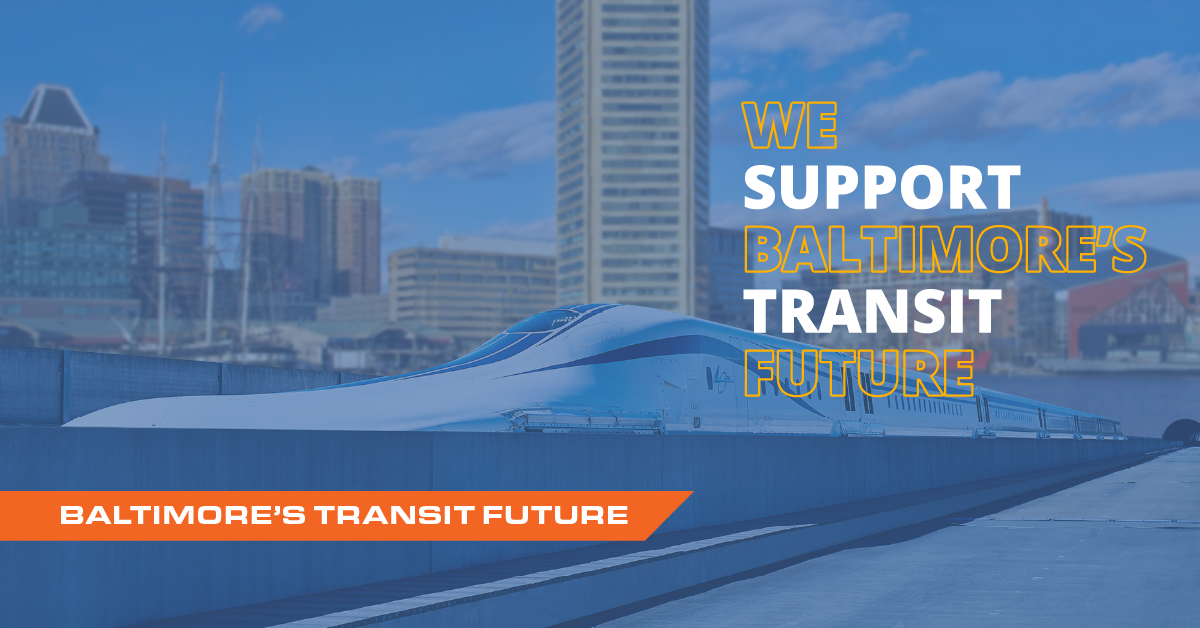We Support Baltimore’s Transit Future
The Greater Baltimore Committee (GBC) and Greater Washington Partnership (GWP) recently released a six-point roadmap to improve our regional transportation system. The plan, entitled Baltimore’s Transit Future provides important points of consideration for local leaders and voters to keep in mind as we head to the polls to choose the leaders who will make decisions and implement infrastructure and transit plans that will impact future generations. Furthermore, this plan aligns with Northeast Maglev’s vision of adding to – and improving – a robust regional transportation system.
Goal 1 – Address MTA Repair Backlog & Operator Shortage
Wisely, the GBC/GWP joint plan recommends that we start at the fundamentals of our transportation system – making critical repairs and addressing staffing shortages. With regional transit at or near capacity, we’ll need additional transportation options to take the burden off of local trains, providing MTA the flexibility to return to a state of good repair and expand operational capacity for local passengers. The (likely) extensive nature of these repairs may require service to temporarily shutter or reroute, impacting the lives and livelihood of the thousands of regional commuters. Furthermore, the result won’t be added capacity; we’ll still have the monumental task of adding new rail tracks and trains to meet the needs of the region’s ever-growing population. Concurrent construction of the SCMAGLEV will provide much-needed capacity, alleviating pressure on MTA systems. Ultimately, there is a need for expanded commuter service and express high-speed service as well as innovative first/last mile connections.
We also support workforce development in transportation fields – ensuring regional residents not only enjoy the benefit of riding the systems, but also the career opportunities they bring. Establishing workforce training and development pipelines in new transportation technologies, like SCMAGLEV, ensures that residents have the skills and training to work on any transportation project around the world. Building our region’s transportation workforce to meet the needs of MTA and the SCMAGLEV will improve the economic futures of thousands of families in the Baltimore-D.C. metropolitan region.
Goal 2 – Establish Frequent, Reliable Bus Service to all Regional Job Centers
One of the most persistent and challenging issues faced by many is the lack of first- and last-mile transportation options available to residents. The last few decades of transit spending and development have largely gone towards fixing regional streets and highways. While keeping our roads and highways in good condition is important, the result has only been increased traffic, air pollution, and an entrenched regional reliance on a mode of transit that is financially inaccessible for many job seekers – cars. Frequent and reliable first/last mile service connects riders to the transportation systems they need to access career opportunities within and outside of the region. The GBC/GWP plan rightly calls for improvements and increased service to job centers, reducing the risk that someone will have to pass on a job opportunity because they cannot reach a work site. Complementing these first- and last-mile solutions, SCMAGLEV will connect riders to millions more career opportunities by connecting job centers along the Northeast Corridor. As a region, we can successfully incorporate both systems and help as many people as possible, but we must ensure there are multiple options available to meet workers’ needs.
Goals 3 and 4 – Support Regional Coordination, Decision Making, and Funding; Implement a 10-Year Rapid Transit Expansion Program
The GBC/GWP plan also calls for better coordination, decision-making and funding. Combined with the recommendation to implement a true comprehensive 10-year plan – the committees have outlined two points crucial to implementing such a plan that incorporates both public and private options. Private sector projects (like SCMAGLEV) can unlock different funding sources, like private investment, additional federal funding, or international financing to improve regional transportation. One of the goals of SCMAGLEV is to improve connections between regional job and activity centers, and regional coordination will ensure it is part of a larger integrated plan to provide more access to opportunities and less reliance on single occupancy vehicles.
Goal 5 – Prioritize Regional Rail Investment
We agree that more investment in MARC service needs to be made – it is a critical service connecting communities with job and activity centers. In conjunction with MARC, SCMAGLEV will provide rapid, safe, and frequent access between major metropolitan areas and airports of the Northeast. Increasing transportation options enhances the region’s ability to sustainably grow its population and employment base.
Goal 6 – Catalyze Equitable Development at Transit and Rail Stations
As the GBC/GWP strategy suggests, the region has several underdeveloped and proposed rail stations that could serve as hubs for thriving, transit-oriented communities, yielding thousands of new jobs, millions in new tax revenues, generate greater transit ridership, and reduce congestion. Development around stations is critical to a successful transit system and key to regional economic and environmental benefits. Northeast Maglev specifically prefers station locations that will encourage the greatest amount of transit-oriented development and therefore bring the greatest amount of benefit to local communities.
Adoption of the GBC/GWP plan will empower regional leaders to build a transportation system that works for the people who will rely on it for years to come. It’s time to take this sensible approach to address our most pressing transportation needs, blending the capabilities of private and public sector options. The result will be a state-of-the-art transit ecosystem that increases opportunities for all and that fuels sustainable, long-term growth.
